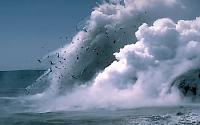
|
|
When Lava Enters the Sea |
Explosions and collapsing land endanger people
Such vivid descriptions and scenes of lava entering the sea along Kilauea's shoreline draw millions of people to Hawai`i who are hoping to witness for themselves growth of new land and experience the remarkable interaction of lava and water. Beautiful and stunning, the explosive interaction can be dangerous to visitors who venture too close to a lava entry point. Also, the new land created by lava entering the sea is unstable. Large areas regularly collapse into the sea, usually triggering a series of stronger explosions and sending a wave of scalding seawater onshore. Such explosions have hurled hot rocks and lava fragments more than 100 m (330 ft) inland!
Unfortunately, the entry of lava into the ocean is difficult to observe from a distance because it's often obscured by an energetic and acidic steam plume or by an abrupt cliff above the entry point. This often invites visitors to jeopardize their safety by walking right up to and over the point where lava enters the ocean. Activity that may appear stable and non threatening can actually change without warning, leaving no time for escape.
 Photograph by T.N Mattox on
September 23, 1993.
|
|
Lava entering the ocean is often hidden beneath a steam plume, which may draw unwary visitors too close to the entry point for safety. |
Why are lava entries so dangerous?
New land created by lava entering the sea looks like a stable platform that extends a few tens to hundreds of meters into the ocean. We refer to this new land as a lava delta. But what can't be seen is the loose pile of unconsolidated lava fragments underneath that supports the new land. This pile of material can easily slide away when the growing delta advances over a steep submarine slope. Areas the size of several football fields can collapse into the ocean with little or no warning.
People standing on a growing lava delta during a collapse event can be swept into the sea, splashed with scalding water, and hit by flying rock debris. Visitors to an active lava delta at Kilauea Volcano are advised not to venture onto the new land. Entry points can only be viewed safely from behind the former sea cliff and shoreline.
Hazardous activity near active lava deltas
- Collapse of new land into the sea
- Explosions at lava entry points
- Waves send scalding water onto new land
Reference
Mattox, T.N, and Mangan, M.T., 1997, Littoral hydrovolcanic
explosions: a case study of lava-seawater interaction at Kilauea
Volcano: Journal of Volcanology and Geothermal Research, v. 75, p.
1-17.
![]()
Contact: hvowebmaster@usgs.gov
Updated: 18 June 2001 (pnf)

 Zones
Zones


